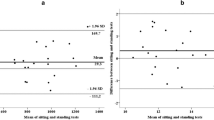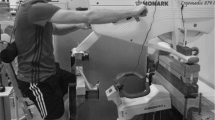Summary
The purpose of the present study was to define the optimal loads (OL) for eliciting maximal power-outputs (PO) in the leg and arm modes of the 30 s Wingate Anaerobic Test (WAnT). Eighteen female and seventeen male physical education students, respectively 20.6±1.6 and 24.1±2.5 years old, volunteered to participate. In each of the total five sessions, the test was administered twice on a convertible, mechanically braked cycle-ergometer, once for the legs and once for the arms. The five randomized, evenly-spaced resistance loads ranged from 2.43 to 5.39 Joule per pedal revolution per kg body weight (B. W.) for the legs, and from 1.96 to 3.92 for the arms. The measured variables were mean (MP·kg−1) and peak PO as well as absolute and relative measures of fatigue. A parabola-fitting technique was employed to define the optimal loads from the MP·kg−1 data. The resulting OL were 5.04 and 5.13 Joule·Rev−1·kg B.W.−1 in the leg and 2.82 and 3.52 in the arm tests for the women and men, respectively. OL were shown to depend on PO magnitude. However, within a two-load span (0.98 Joule·Rev−1·kg B.W.−1) about the OL, MP·kg−1 did not vary by more than 1.4% in the leg and 2.2% in the arm tests. It is suggested that although the WAnT is rather insensitive to moderate variation in load assignment, improved results could be obtained by using the stated OL as guidelines that may be modified according to individual body build, composition, and, particularly, anaerobic fitness level.
Similar content being viewed by others
References
Ayalon A, Inbar O, Bar-Or O (1974) Relationship among measurements of explosive strength and aerobic power. In: Nelson RC, Morehouse CA (eds) Biomechanics IV. International Series on Sport Sciences, vol I. MacMillan, New York, pp 572–577
Bar-Or O, Dotan R, Inbar O (1977) A 30 s all-out ergometry test — its reliability and validity for anaerobic capacity [Abstr]. Isr J Med Sci 13: 326–327
Bar-Or O (1980) Um novo teste de capacidade anaerobica — characteristica e applicabilidade. Med Esporte-Porto Alegre 5: 73–82
Cavagna GA, Komarek L, Mazzoleni S (1971) The mechanics of sprint running. J Physiol (Lond) 217: 709–721
Craig Jr, AB, Pendergast R (1979) Relationships of stroke rate, distance per stroke and velocity in competitive swimming. Med Sci Sports 2: 278–283
Dotan R, Bar-Or O (1980) Climatic heat stress and performance in the Wingate Anaerobic Test. Eur J Appl Physiol 44: 237–243
Evans JA, Quinney HA (1981) Determination of resistance settings for an aerobic power testing. Can J Appl Sport Sci 6: 53–56
Hagberg JM, Mullin JP, Giese MD, Spitznagel E (1981) Effect of pedalling rate on submaximal exercise responses of competitive cyclists. J Appl Physiol 51: 447–451
Harrison JY (1970) Maximizing human power output by suitable selection of motion cycle and load. Human Factors 12: 315–329
Hill AV (1938) The heat of shortening and the dynamic constants of muscle. Proc R Soc B 126: 136–195
Jacobs I (1980) The effects of thermal dehydration on performance of the Wingate Anaerobic Test. Int J Sports Med 1: 21–24
Kaneko M, Yamazaki T (1978) Internal mechanical work due to velocity changes of the limb in working on a bicycle ergometer. In: Asmussen E, JØrgensen K (eds) Biomechanics VI-A. International series on biomechanics, vol IIA. University Park Press, Baltimore, pp 86–92
Kyle CR, Mastropaolo J (1976) Predicting racing bicyclist performance using the unbraked flywheel method of bicycle ergometry. Presented at the International Congress of Physical Activity Sciences, Quebec City, Canada
Löllgen H, Ulmer HV, Gross R, Wilbert G, Nieding GV (1975) Methodical aspects of perceived exertion rating and its relation to pedalling rate and rotating mass. Eur J Appl Physiol 34: 205–215
Löllgen H, Ulmer HV, Nieding GV (1977) Heart rate and perceptual response to exercise with different pedalling speed in normal subjects and patients. Eur J Appl Physiol 37: 297–304
Luhtanen P, Komi PV (1978) Mechanical factors influencing running speed. In: Assmussen E, JØrgensen K (eds) Biomechanics VI-A. International series on biomechanics, vol IIA. University Park Press, Baltimore, pp 23–29
Mayers N, Gutin B (1979) Physiological characteristics of elite prepubertal cross-country runners. Med Sci Sports 11: 172–176
Moffatt RJ, Stanford BA (1978) Effects of pedalling rate changes on maximal oxygen uptake and perceived effort during bicycle ergometer work. Med Sci Sports 10: 27–31
Pugh LGCE (1974) The relation of oxygen intake and speed in competition cycling and comparative observations on the bicycle ergometer. J Physiol 241: 795–808
Quintana G, Guig A, Huberman J, Holtztsy M, Donoso M (1981) Application and analysis of the measurement of anaerobic capacity (Wingate Test) in different sports [in Spanish]. Presented at the Pan-American Congress and International Course on Sports Medicine and Exercise Science, Miami
Saito M, Kobayashi K, Mayashita M, Hoshikawa T (1974) Temporal patterns in running. In: Nelson RC, Morehouse CA (eds) Biomechanics IV. International Series on Sports Sciences, vol 1, MacMillan, New York, pp 106–111
Sargeant AJ (1978) Force velocity relationship and power output in short-term dynamic exercise. Fed Proc 37: 429 (Abstr)
Seabury JJ, Adams WC, Ramey MR (1977) The influence of pedalling rate and power output on energy expenditure during bicycle ergometry. Ergonomics 20: 491–498
Soden PD, Adeyefa BA (1979) Force applied to a bicycle during normal cycling. J Biomech 12: 527–541
Suzuki Y (1979) Mechanical efflciency of fast and slow twitch muscle fibers in man during cycling. J Appl Physiol 47: 263–267
Taylor HL, Buskirk E, Henschel A (1955) Maximal oxygen intake as an objective measure of cardiorespiratory performance. J Appl Physiol 8: 73–80
TØnnesen KH (1964) Blood flow through muscle during rythmic contraction measured by 133-xenon. Scand J Clin Lab Invest 16: 646–654
Ulmer HV (1969) Die AbhÄngigkeit des Leistungsempfindens von der Tretfrequenz bei Radsportlern. Sportarzt Sportmed 20: 390–395
Author information
Authors and Affiliations
Additional information
This study was funded by a research grant from the Sports and Physical Education Authority, The Ministry of Education and Culture, Israel
Rights and permissions
About this article
Cite this article
Dotan, R., Bar-Or, O. Load optimization for the wingate anaerobic test. Europ. J. Appl. Physiol. 51, 409–417 (1983). https://doi.org/10.1007/BF00429077
Accepted:
Issue Date:
DOI: https://doi.org/10.1007/BF00429077




